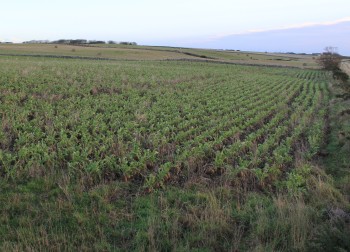Supporting guidance for Forage Brassica Crops for Farmland Birds
This is an old version of the page
Date published: 30 March, 2015
Date superseded: 12 December, 2016
Forage brassicas provide a good habitat for a wide range of wildlife, particularly food and cover for wintering farmland birds.

Forage brassicas – Credit: Hywel Maggs
Winter seed sources such as weedy fodder crops and seed-rich cereal stubbles are scarcer today, especially in livestock areas.
The Forage Brassica Crops for Farmland Birds option helps to provide habitat diversity in pastoral landscapes, reverse the decline in forage cropping and provide food and cover for a range of farmland birds during the winter.
Seeds of certain weed species are an excellent, protein-rich source of food for farmland birds such as twite and linnet. Restrictions on herbicide use allow weeds to establish and set seed, providing a good source of winter food.
Desirable weeds include charlock, fat-hen, knot grass and redshank. These species provide seed without having a significant impact on crop yield.

Redshank – © Plantlife
Establishing and managing the crop
Consider:
- forage brassica crops include turnips, kale, rape and swedes
- establish the crop in the spring / summer using standard recommendations for the crop you have chosen
- aim to produce a satisfactory crop yield combined with beneficial weeds
- fertiliser can be applied according to crop requirements
- a moderate weed cover later in the year should have limited effect on the yield of brassica crops as they are good competitors with weeds once established
- the crop cannot be grazed or cultivated until 1 March
Further information
Further information on the benefits of forage brassica crops and how to establish them is available:
